Analysis of Dry/Wet Variations in the Poyang Lake Basin Using Standardized Precipitation Evapotranspiration Index Based on Two Potential Evapotranspiration Algorithms
Abstract
1. Introduction
2. Data and Methods
2.1. Study Area and Meteorological Data
2.2. Methods
2.2.1. PET Estimation Methods
2.2.2. SPI Calculation
2.2.3. SPEI Calculation
2.2.4. Trend Analysis
3. Results and Discussion
3.1. Spatial and Temporal Variation in the SPEI_pm and SPEI_th
3.1.1. Temporal Variation
3.1.2. Spatial Variation
3.2. Frequency of Dry and Wet Class Based on the SPEI_pm and SPEI_th
3.3. Analysis of Differences between SPEI_pm and SPEI_th
3.3.1. Variation of Sen’s Slope within 30-Year Window
3.3.2. The Relationships between Precipitation, PET and SPEI_th/SPEI_pm
3.3.3. Applicability of the SPEI_pm and SPEI_th in Poyang Lake Basin
3.4. Comparison between SPI and SPEI for Dry/Wet Variations
4. Conclusions
- Both SPEI_pm and SPEI_th showed a trend of humidification in the Poyang Lake basin on an annual scale as well as seasonal scales, except for spring and autumn during the period 1958–2013. A drying trend was observed in the spring. Considering the importance of spring for crop growth, the drying trend in spring might have an impact on crop yields. In autumn, the changes of dry and wet conditions in two SPEIs had opposite trends. However, all trends from two SPEIs were not significant, while in summer, the increasing trend from SPEI_pm was more significant throughout the whole season.
- From the spatial perspective, the whole Poyang Lake basin was mainly dominated by the wetting tendency in the annual scale. Almost all the meteorological stations were characterized by increasing trends in summer and winter, especially for the summer SPEI_pm. A few stations in the central and northeast Poyang Lake basin were characterized by non-significant increasing trends, which indicated that a wet tendency dominated the Poyang Lake basin in summer. A drying trend was observed in almost all the stations in spring, which indicated that a dry tendency dominated the Poyang Lake basin in spring, although the trends were not significant at the 95% confidence level. When using the SPEI_pm to detect the trends in autumn, almost two-thirds of the meteorological stations were characterized by increasing trends, whereas all the stations were characterized by decreasing trends in autumn when using the SPEI_th.
- The highest frequency of dry episodes occurred in autumn, with a frequency of 17.6%, and then followed by about 15% in winter. For wet episodes, the most frequent occurrence was in winter, varying from 18% to 20%, and the second-highest frequency occurred in spring, with the same frequency of 18.8%. Overall, the frequencies of dryness and wetness of different categories calculated from SPEI_pm were consistent with those from SPEI_th, but compared to the SPEI_th, the occurrence of wet episodes was more frequent in the SPEI_pm on the seasonal scale as well as annual scale in the Poyang Lake basin during 1958 to 2013.
- Significant positive correlations were detected between precipitation and SPEI_th/SPEI_pm, with the high correlation coefficients above 0.95, whereas negative correlations were detected between PET and SPEI_th/SPEI_pm, with the correlation coefficients ranging from −0.17 to −0.85, and the correlation of SPEI_pm and ET_pm was stronger than that between SPEI_th and ET_th. This study revealed that although precipitation was a dominant factor to determine change in the dry and wet conditions in our study area, PET may play a modulating role in wet and dry changes in the Poyang Lake basin, which made the differences between the two SPEIs. On the other hand, despite the obvious differences between ET_pm and ET_th, trends in the SPEI_pm series were generally consistent with those in the SPEI_th series, revealing that the method for PET calculation was not critical to the change in dry/wet conditions.
- Furthermore, the results of the conditional probability of SPEI_pm and SPEI_th showed that both SPEI_pm and SPEI_th could better detect wet or dry events that were identified by SPEI_pm or SPEI_th. In other words, SPEI_th could identify a drought or wet condition that was detected with SPEI_pm within the same historical period. Therefore, SPEI_th is basically feasible for analysis of wetness and dryness in the Poyang Lake basin, where meteorological data is scarce.
Author Contributions
Funding
Conflicts of Interest
Appendix A
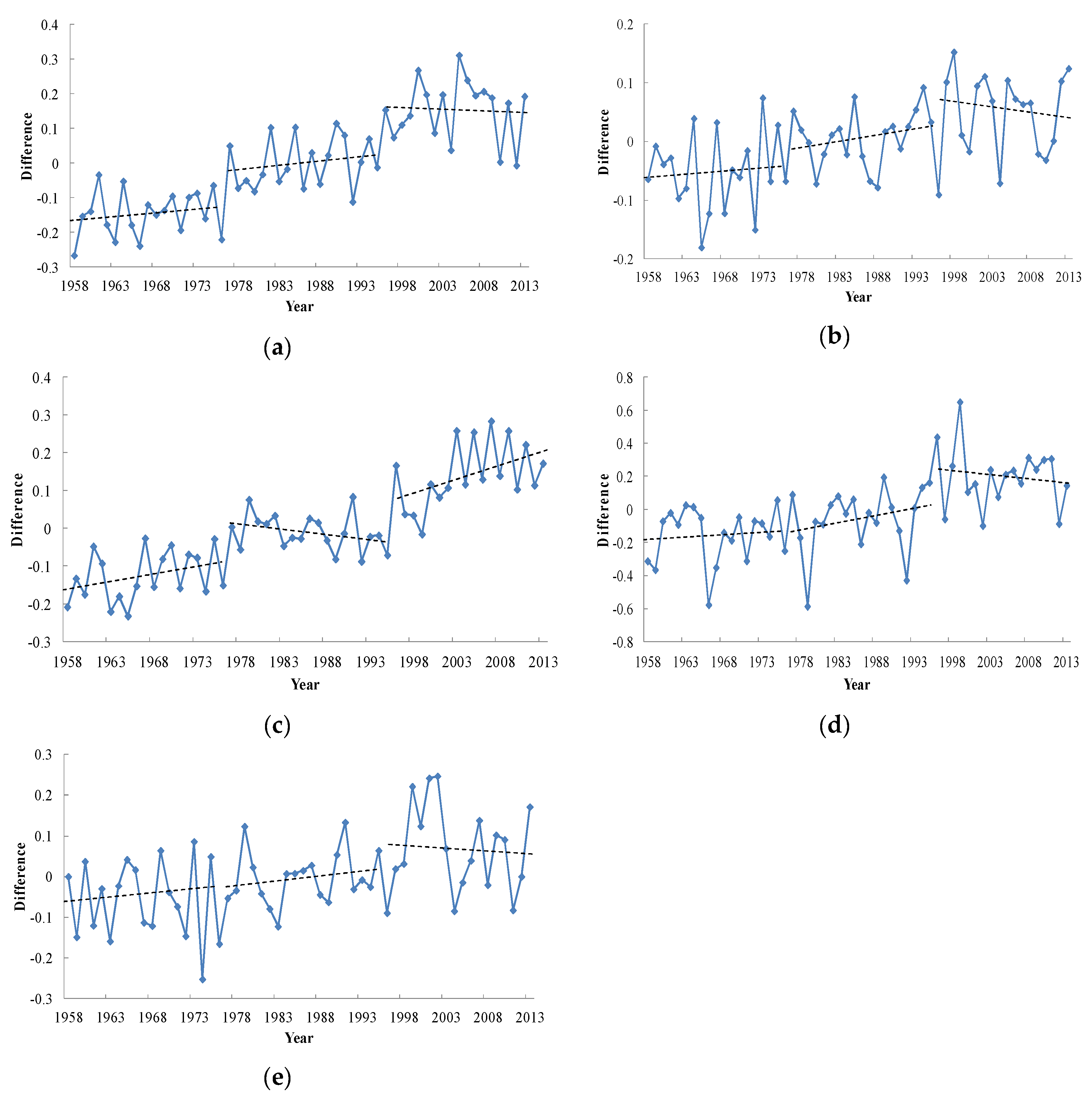
References
- Stocker, T.; Qin, D.; Plattner, G.K.; Tignor, M.; Allen, S.K.; Boschung, J.; Nauels, A.; Xia, Y.; Bex, V.; Midgley, P.M. Climate Change 2013: The Physical Science Basis; Cambridge University Press: Cambridge, UK, 2014. [Google Scholar]
- Xu, S.; Yu, Z.; Yang, C.; Ji, X.; Zhang, K. Trends in evapotranspiration and their responses to climate change and vegetation greening over the upper reaches of the Yellow River Basin. Agric. For. Meteorol. 2018, 263, 118–129. [Google Scholar] [CrossRef]
- Zhang, Q.; Xu, C.Y.; Zhang, Z. Observed changes of drought/wetness episodes in the Pearl River basin, China, using the standardized precipitation index and aridity index. Theor. Appl. Climatol. 2009, 98, 89–99. [Google Scholar] [CrossRef]
- Trenberth, K.E. Attribution of climate variations and trends to human influences and natural variability. Wiley Interdiscip. Rev. Clim. Chang. 2011, 2, 925–930. [Google Scholar] [CrossRef]
- Ionita, M.; Scholz, P.; Chelcea, S. Spatio-temporal variability of dryness/wetness in the Danube River Basin. Hydrol. Process. 2015, 29, 4483–4497. [Google Scholar] [CrossRef]
- Du, J.; Fang, J.; Xu, W.; Shi, P. Analysis of dry/wet conditions using the standardized precipitation index and its potential usefulness for drought/flood monitoring in Hunan Province, China. Stoch. Environ. Res. Risk Assess. 2013, 27, 377–387. [Google Scholar] [CrossRef]
- Wang, L.N.; Zhu, Q.K.; Zhao, W.J.; Zhao, X.K. The drought trend and its relationship with rainfall intensity in the Loess Plateau of China. Nat. Hazard 2015, 77, 479–495. [Google Scholar] [CrossRef]
- Chen, F.; Huang, W.; Jin, L. Spatiotemporal precipitation variations in the arid Central Asia in the context of global warming. Sci. China Earth Sci. 2011, 54, 1812–1821. [Google Scholar] [CrossRef]
- McKee, T.B.; Doesken, N.J.; Kleist, J. The relationship of drought frequency and duration to time scales. In Proceedings of the 8th Conference on Applied Climatology; American Meteorological Society: Boston, MA, USA, 1993; pp. 179–183. [Google Scholar]
- Li, J.B.; Zheng, Y.Y.; Gao, C.H.; Yang, Y. A discussion on geographical regularity of flood and drought in Hunan Province. J. Nat. Disasters 2000, 9, 115–120. [Google Scholar]
- Bordi, I.; Fraedrich, K.; Jiang, J.M.; Sutera, A. Spatio-temporal variability of dry and wet periods in eastern China. Theor. Appl. Climatol. 2004, 79, 81–91. [Google Scholar] [CrossRef]
- Seiler, R.A.; Hayes, M.; Bressan, L. Using the standardized precipitation index for flood risk monitoring. Int. J. Climatol. 2002, 22, 1365–1376. [Google Scholar] [CrossRef]
- Törnros, T.; Menzel, L. Addressing drought conditions under current and future climates in the Jordan River region. Hydrol. Earth Syst. Sci. 2014, 18, 305–318. [Google Scholar] [CrossRef]
- Li, X.; He, B.; Quan, X.; Liao, Z.; Bai, X. Use of the standardized precipitation evapotranspiration index (SPEI) to characterize the drying trend in southwest China from 1982–2012. Remote Sens. 2015, 7, 10917–10937. [Google Scholar] [CrossRef]
- Vicente-Serrano, S.M.; Beguería, S.; Lorenzo-Lacruz, J.; Camarero, J.J.; López-Moreno, J.I.; Azorin-Molina, C.; Revuelto, J.; Morán-Tejeda, E.; Sanchez-Lorenzo, A. Performance of drought indices for ecological, agricultural, and hydrological applications. Earth Interact. 2012, 16, 1–27. [Google Scholar] [CrossRef]
- Tang, W.J.; Yang, K.; Qin, J.; Cheng, C.C.K.; He, J. Solar radiation trend across China in recent decades: A revisit with quality-controlled data. Atmos. Chem. Phys. 2011, 11, 393–406. [Google Scholar] [CrossRef]
- Fan, Z.; Thomas, A. Decadal changes of reference crop evapotranspiration attribution: Spatial and temporal variability over China 1960–2011. J. Hydrol. 2018, 560, 461–470. [Google Scholar] [CrossRef]
- Liu, K.; Jiang, D. Analysis of dryness/wetness over China using standardized precipitation evapotranspiration index based on two evapotranspiration algorithms. Chin. J. Atmos. Sci. 2015, 39, 23–36. [Google Scholar]
- Hu, Q.; Pan, F.; Pan, X.; Hu, L.; Wang, X.; Yang, P.; Pan, Z. Dry-wet variations and cause analysis in Northeast China at multi-time scales. Theor. Appl. Climatol. 2018, 133, 775–786. [Google Scholar] [CrossRef]
- Vicente-Serrano, S.M.; Begueria, S.; Lopez-Moreno, J.I. A multiscalar drought index sensitive to global warming: The standardized precipitation evapotranspiration index. J. Clim. 2010, 23, 1696–1718. [Google Scholar] [CrossRef]
- Chai, R.; Chen, H.; Sun, S. Attribution analysis of dryness/wetness change over China based on SPEI. J. Meteorol. Sci. 2018, 38, 423–431. [Google Scholar]
- Gao, X.; Zhao, Q.; Zhao, X.; Wu, P.; Pan, W.; Gao, X.; Sun, M. Temporal and spatial evolution of the standardized precipitation evapotranspiration index (SPEI) in the Loess Plateau under climate change from 2001 to 2050. Sci. Total Environ. 2017, 595, 191–200. [Google Scholar] [CrossRef]
- Lee, S.H.; Yoo, S.H.; Choi, J.Y.; Bae, S. Assessment of the impact of climate change on drought characteristics in the Hwanghae plain, North Korea using time series SPI and SPEI: 1981–2100. Water 2017, 9, 579. [Google Scholar] [CrossRef]
- Tan, C.; Yang, J.; Li, M. Temporal-spatial variation of drought indicated by SPI and SPEI in Ningxia Hui autonomous region, China. Atmosphere 2015, 6, 1399–1421. [Google Scholar] [CrossRef]
- Jiang, R.; Xie, J.; He, H.; Luo, J.; Zhu, J. Use of four drought indices for evaluating drought characteristics under climate change in Shaanxi, China: 1951–2012. Nat. Hazards 2015, 75, 2885–2903. [Google Scholar] [CrossRef]
- Tam, B.Y.; Szeto, K.; Bonsal, B.; Flato, G.; Cannon, A.J.; Rong, R. CMIP5 drought projections in Canada based on the standardized precipitation evapotranspiration index. Can. Water Res. J. 2019, 44, 90–107. [Google Scholar] [CrossRef]
- Vicente-Serrano, S.M.; Schrier, G.V.D.; Beguería, S.; Azorin-Molina, C.; Lopez-Moreno, J. Contribution of precipitation and reference evapotranspiration to drought indices under different climates. J. Hydrol. 2015, 526, 42–54. [Google Scholar] [CrossRef]
- Thornthwaite, C.W.; Mather, J.R. The role of evapotranspiration in climate. Arch. Meteorol. Geophys. Bioklimatol. 1951, 3, 16–39. [Google Scholar] [CrossRef]
- Seong, C.; Sridhar, V.; Billah, M.M. Implications of potential evapotranspiration methods for streamflow estimations under changing climatic conditions. Int. J. Climatol. 2018, 38, 896–914. [Google Scholar] [CrossRef]
- Liu, S.; Kang, W.; Wang, T. Drought variability in Inner Mongolia of northern China during 1960–2013 based on standardized precipitation evapotranspiration index. Environ. Earth Sci. 2016, 75, 145. [Google Scholar] [CrossRef]
- Van der Schrier, G.; Jones, P.D.; Briffa, K.R. The sensitivity of the PDSI to the thornthwaite and penman-monteith parameterizations for potential evapotranspiration. J. Geophys. Res. Atmos. 2011, 116. [Google Scholar] [CrossRef]
- Tabari, H.; Grismer, M.E.; Trajkovic, S. Comparative analysis of 31 reference evapotranspiration methods under humid conditions. Irrig. Sci. 2013, 31, 107–117. [Google Scholar] [CrossRef]
- Allen, R.G.; Pereira, L.S.; Raes, D.; Smith, M. Crop Evapotranspiration-Guidelines for Computing Crop Water Requirements; FAO Irrigation and Drainage Paper 56; FAO: Roma, Italia, 1998. [Google Scholar]
- Stockle, C.O.; Kjelgaard, J.; Bellocchi, G. Evaluation of estimated weather data for calculating Penman-Monteith reference crop evapotranspiration. Irrig. Sci. 2004, 23, 39–46. [Google Scholar] [CrossRef]
- Lang, D.; Zheng, J.; Shi, J.; Liao, F.; Ma, X.; Wang, W.; Zhang, M. A comparative study of potential evapotranspiration estimation by eight methods with FAO Penman—Monteith method in southwestern China. Water 2017, 9, 734. [Google Scholar] [CrossRef]
- Djaman, K.; Balde, A.B.; Sow, A.; Muller, B.; Irmak, S.; N’Diaye, M.K.; Saito, K. Evaluation of sixteen reference evapotranspiration methods under sahelian conditions in the Senegal River Valley. J. Hydrol. Reg. Stud. 2015, 3, 139–159. [Google Scholar] [CrossRef]
- Li, X.; Zhang, Q.; Ye, X. Dry/wet conditions monitoring based on TRMM rainfall data and its reliability validation over Poyang Lake Basin, China. Water 2013, 5, 1848–1864. [Google Scholar] [CrossRef]
- Zhang, Q.; Xiao, M.; Singh, V.P.; Chen, Y.D. Max-stable based evaluation of impacts of climate indices on extreme precipitation processes across the Poyang Lake basin, China. Glob. Planet. Change 2014, 122, 271–281. [Google Scholar] [CrossRef]
- Min, S.; Yan, M.; Liu, J. Climatic characteristics of the drought in Lake Poyang catchment. J. Lake Sci. 2013, 25, 65–72. [Google Scholar]
- Gu, C.; Mu, X.; Zhao, G.; Gao, P.; Sun, W.; Yu, Q. Changes in stream flow and their relationships with climatic variations and anthropogenic activities in the Poyang Lake Basin, China. Water 2016, 8, 564. [Google Scholar] [CrossRef]
- Zhang, Q.; Xiao, M.; Singh, V.P.; Wang, Y. Spatiotemporal variations of temperature and precipitation extremes in the Poyang Lake Basin, China. Appl. Clim. 2016, 124, 855–864. [Google Scholar] [CrossRef]
- Tao, H.; Fraedrich, K.; Menz, C.; Zhai, J. Trends in extreme temperature indices in the Poyang Lake Basin, China. Stoch. Environ. Res. Risk Assess. 2014, 28, 1543–1553. [Google Scholar] [CrossRef]
- Sun, S.L.; Zhou, S.Q.; Song, J.; Shi, J.H.; Gu, R.Y.; Ma, F.M. Change in pan evaporation and its driving factors in Jiangxi Province. Trans. Chin. Soc. Agric. Eng. 2010, 26, 59–65. [Google Scholar]
- Shao, J.; Wang, J.; Lv, S.; Bing, J. Spatial and temporal variability of seasonal precipitation in Poyang Lake Basin and possible links with climate indices. Hydrol. Res. 2016, 47, 51–68. [Google Scholar] [CrossRef]
- Hong, X.; Guo, S.; Xiong, L.; Liu, Z. Spatial and temporal analysis of drought using entropy-based standardized precipitation index: A case study in Poyang Lake basin, China. Theor. Appl. Climatol. 2015, 122, 543–556. [Google Scholar] [CrossRef]
- Gocic, M.; Trajkovic, S. Analysis of changes in meteorological variables using Mann-Kendall and sen’s slope estimator statistical tests in Serbia. Glob. Planet. Chang. 2013, 100, 172–182. [Google Scholar] [CrossRef]
- Wang, Z.; Ye, A.; Wang, L.; Liu, K.; Cheng, L. Spatial and temporal characteristics of reference evapotranspiration and its climatic driving factors over China from 1979–2015. Agric. Water Manag. 2019, 213, 1096–1108. [Google Scholar] [CrossRef]
- Sen, P.K. Estimates of the regression coefficient based on Kendall’s tau. J. Am. Stat. Assoc. 1968, 63, 1379–1389. [Google Scholar] [CrossRef]
- Qin, W.; Guo, Q.; Zuo, C.; Shan, Z.; Ma, L.; Sun, G. Spatial distribution and temporal trends of rainfall erosivity in mainland China for 1951–2010. Catena 2016, 147, 177–186. [Google Scholar] [CrossRef]
- Gentilucci, M.; Materazzi, M.; Pambianchi, G.; Burt, P.; Guerriero, G. Assessment of variations in the temperature-rainfall trend in the province of Macerata (Central Italy), comparing the last three climatological standard normals (1961–1990; 1971–2000; 1981–2010) for biosustainability studies. Environ. Process. 2019, 1–22. [Google Scholar] [CrossRef]
- Gocic, M.; Shamshirband, S.; Razak, Z.; Petković, D.; Ch, S.; Trajkovic, S. Long-term precipitation analysis and estimation of precipitation concentration index using three support vector machine methods. Adv. Meteorol. 2016, 2016. [Google Scholar] [CrossRef]
- Fiedler, F.R. Simple, practical method for determining station weights using Thiessen polygons and isohyetal maps. J. Hydrol. Eng. 2003, 8, 219–221. [Google Scholar] [CrossRef]
- Ye, X.C.; Li, Y.L.; Li, X.H.; Xu, C.Y.; Zhang, Q. Investigation of the variability and implications of meteorological dry/wet conditions in the Poyang Lake catchment, China, during the period 1960–2010. Adv. Meteorol. 2015, 2015. [Google Scholar] [CrossRef]
- Tu, A.; Li, Y.; Mo, M.; Nie, X. Spatial and temporal variations of reference crop evapotranspiration and its influencing factors in Poyang Lake Watershed. Ecol. Environ. Sci. 2017, 26, 211–218. [Google Scholar]
- Liu, J.; Zhang, Q.; Xu, C.; Zhai, J.; Jin, X. Change of actual evapotranspiration of Poyang Lake Watershed and associated influencing factors in the past 50 years. Res. Environ. Yangtze Basin 2010, 19, 139–145. [Google Scholar]
- Wang, W.; Zhu, Y.; Xu, R.; Liu, J. Drought severity change in China during 1961–2012 indicated by SPI and SPEI. Nat. Hazards 2015, 75, 2437–2451. [Google Scholar] [CrossRef]
- Li, X.; Sha, J.; Wang, Z.L. Comparison of drought indices in the analysis of spatial and temporal changes of climatic drought events in a basin. Environ. Sci. Pollut. Res. 2019, 26, 1–13. [Google Scholar] [CrossRef] [PubMed]
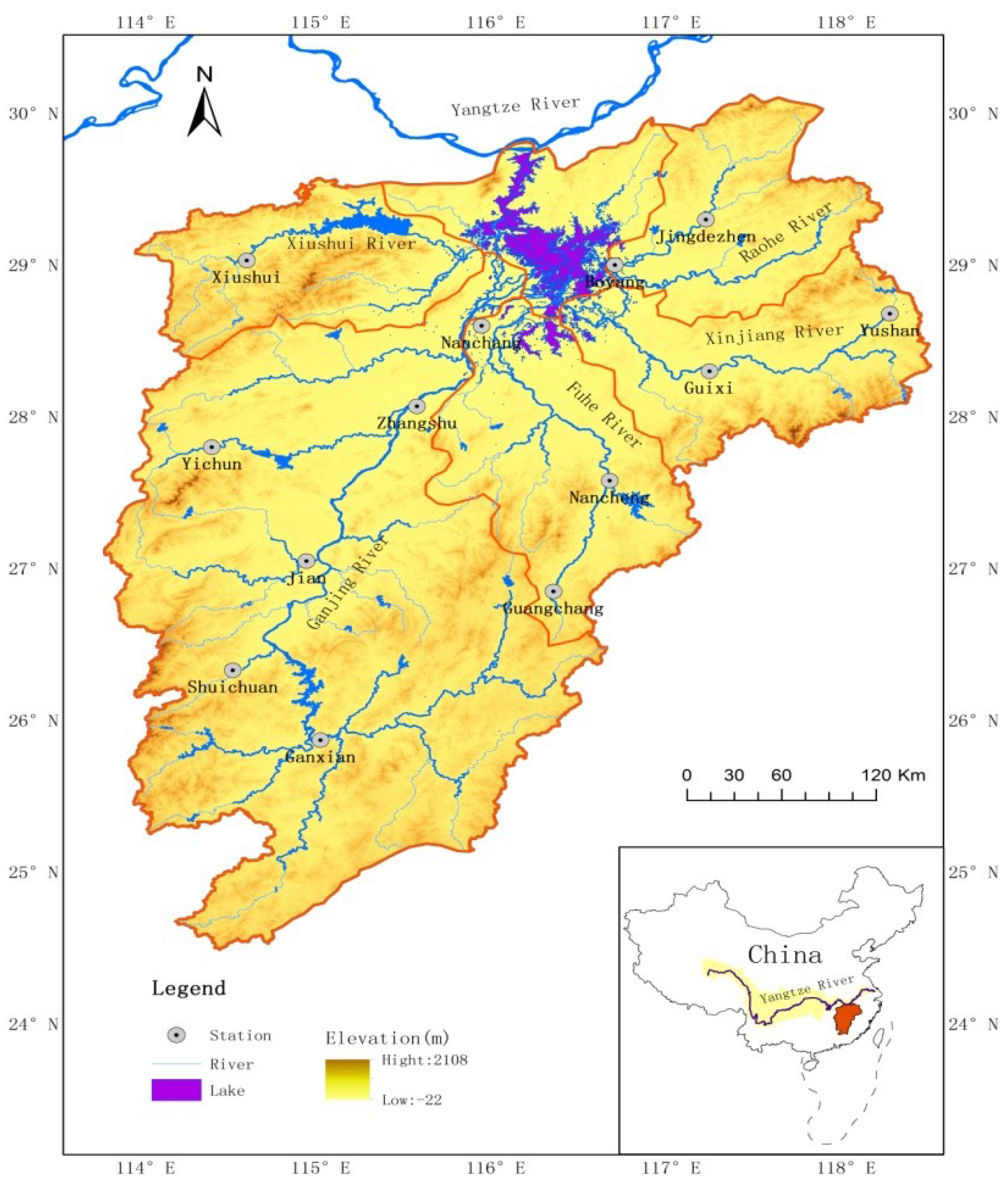
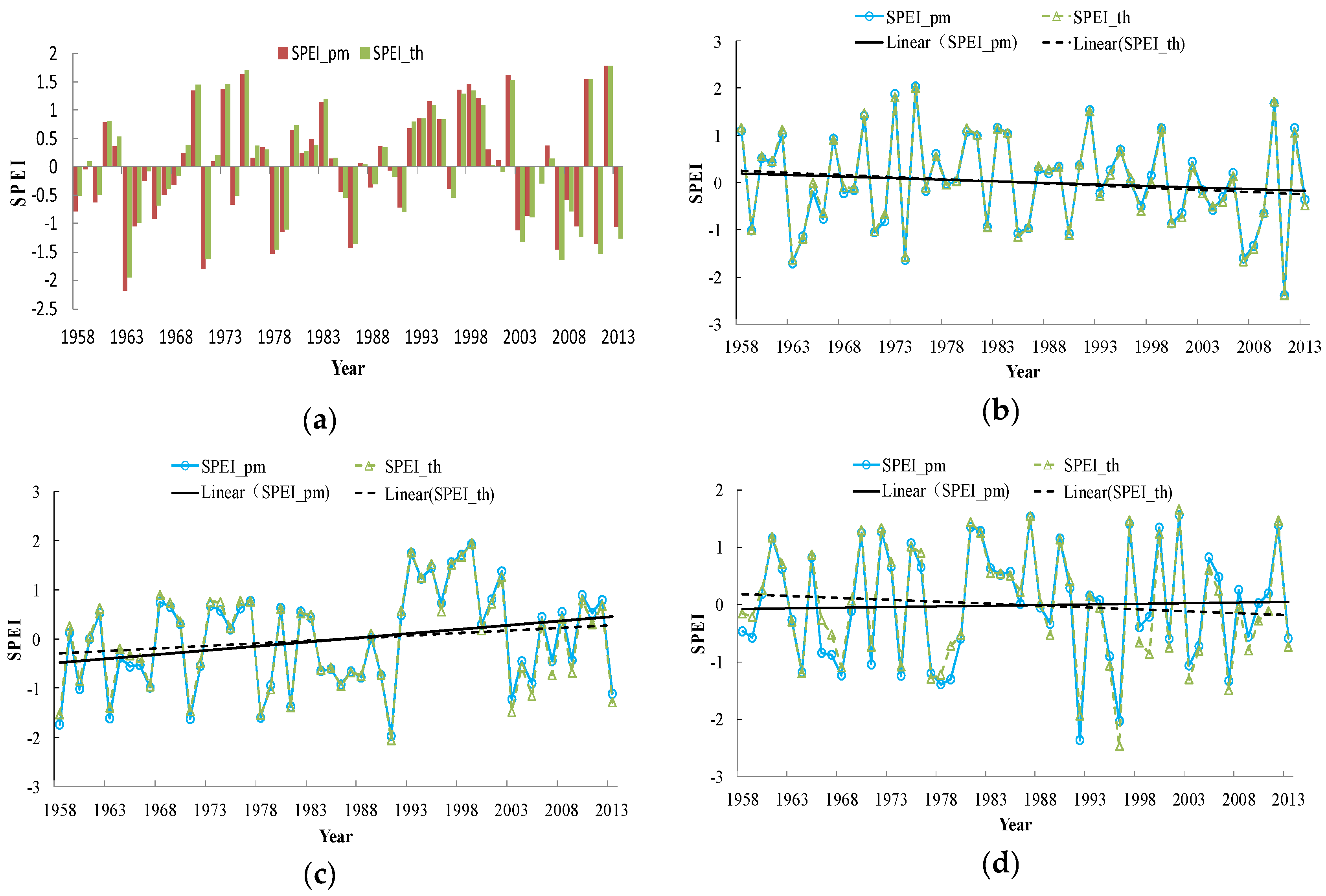

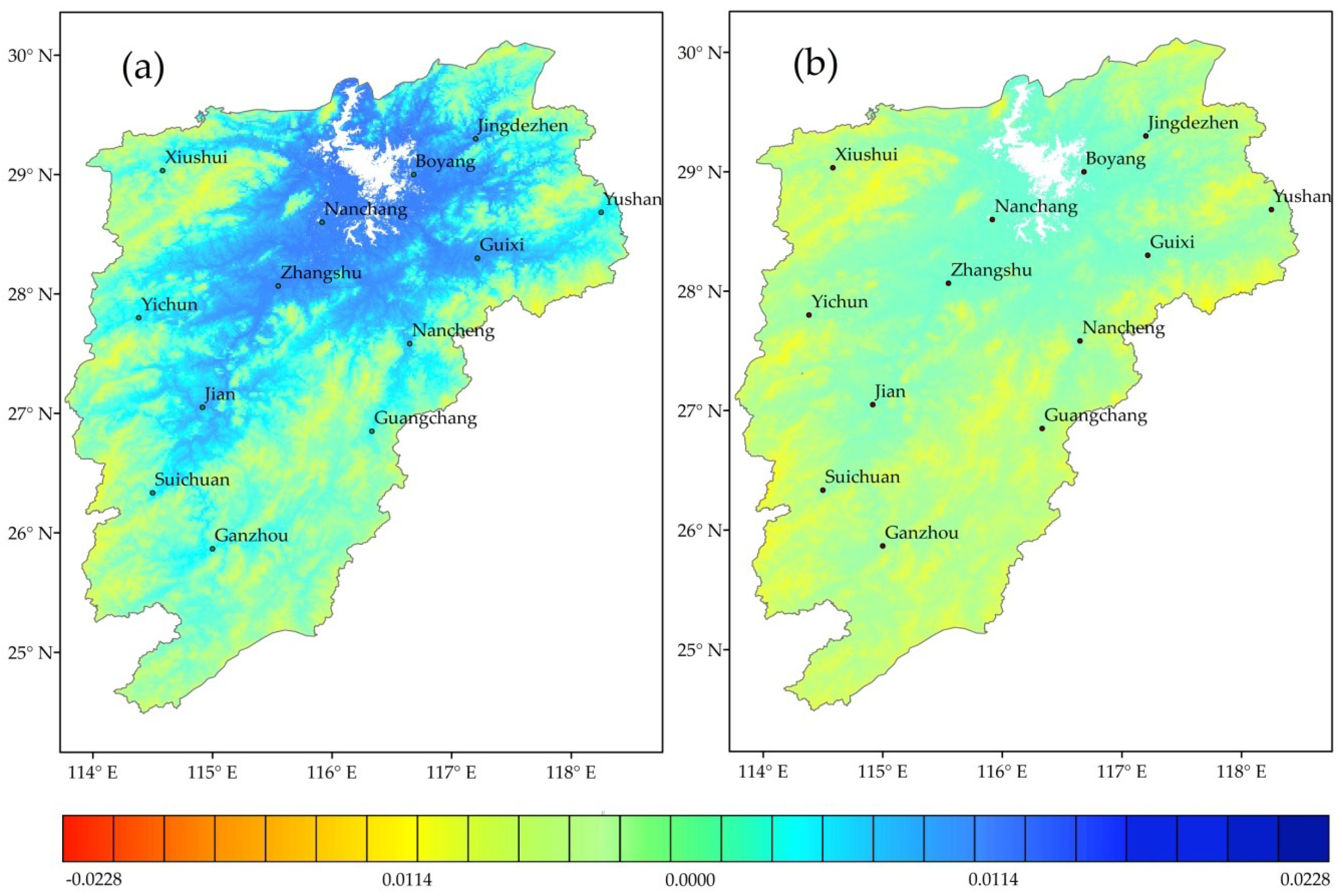
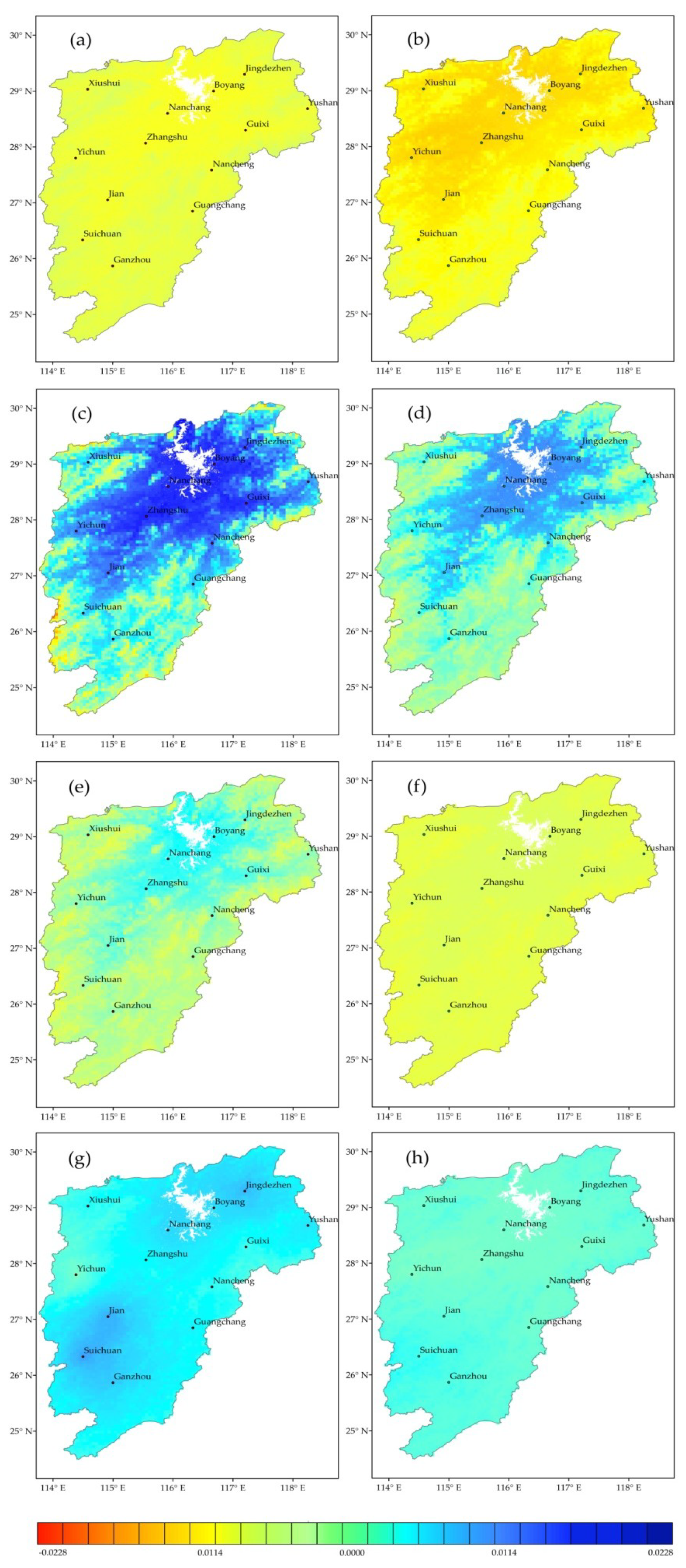
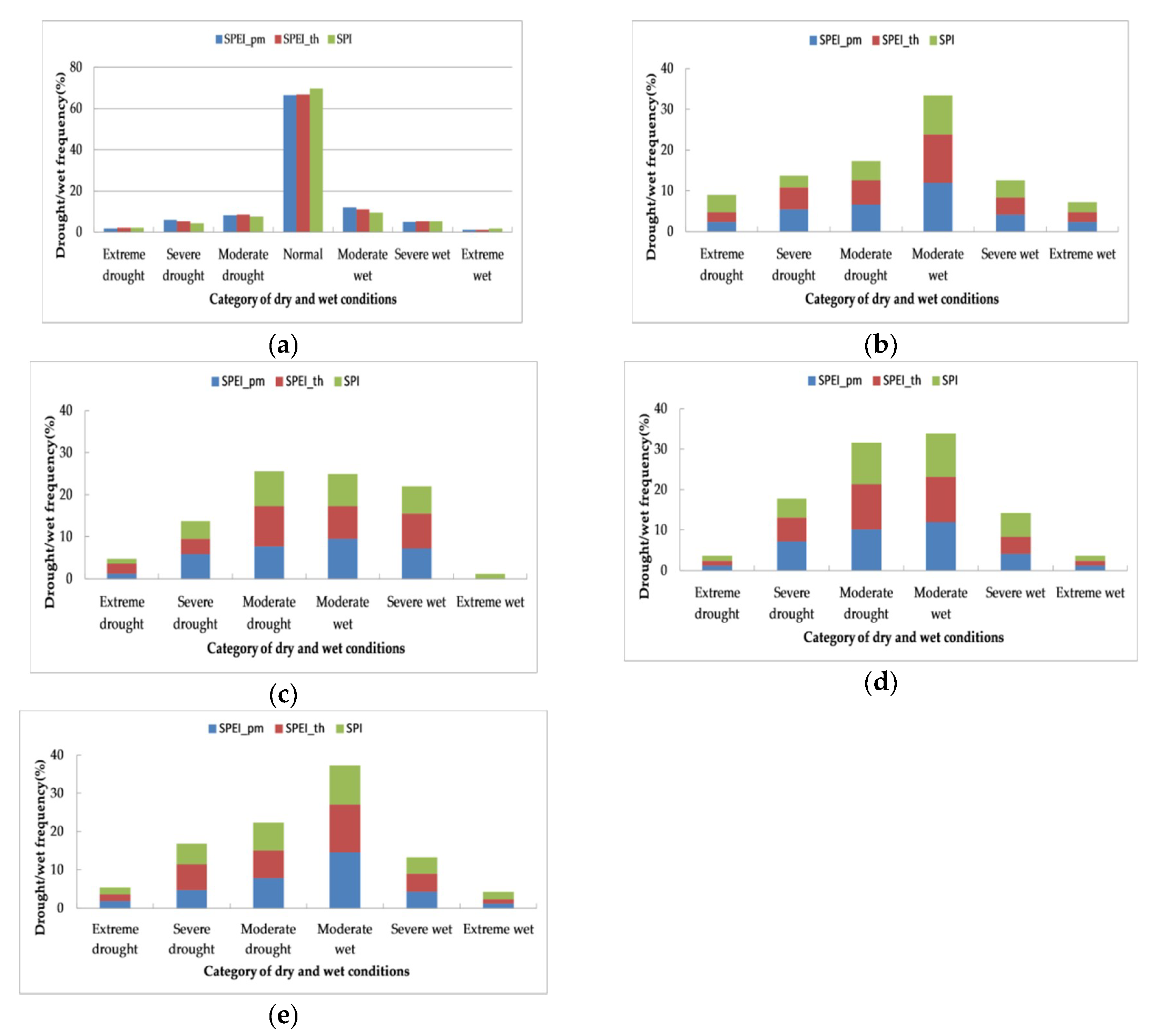
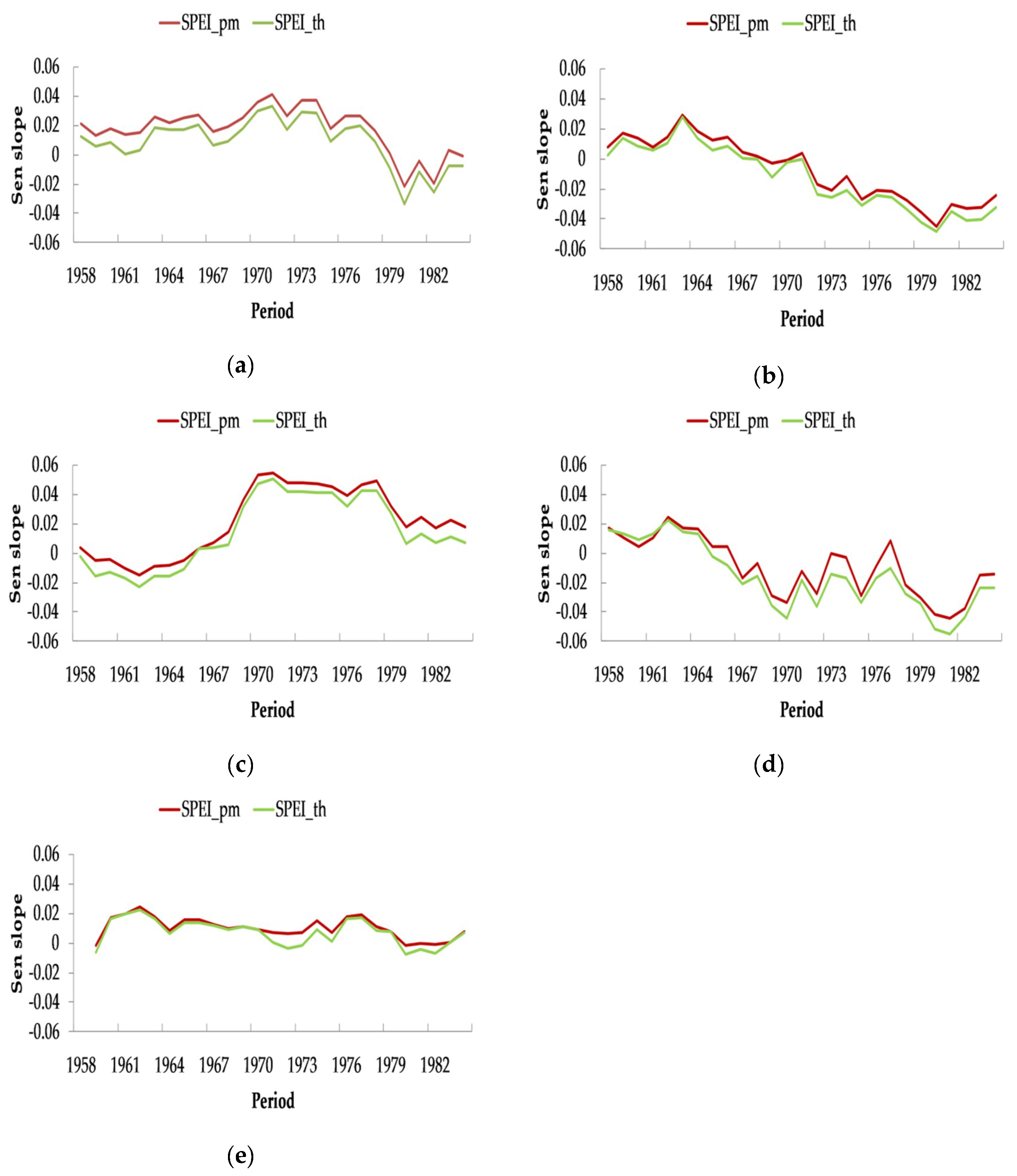
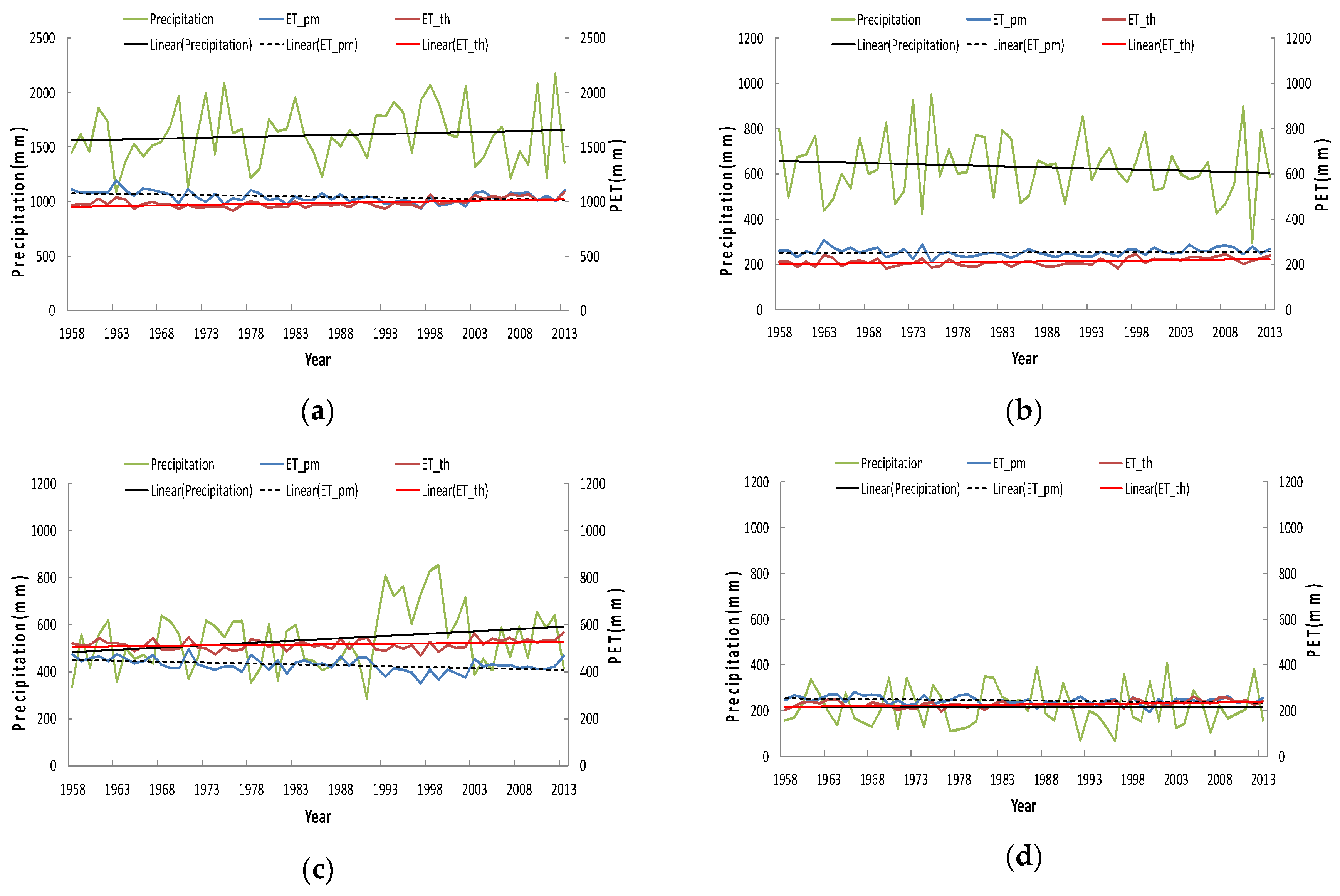
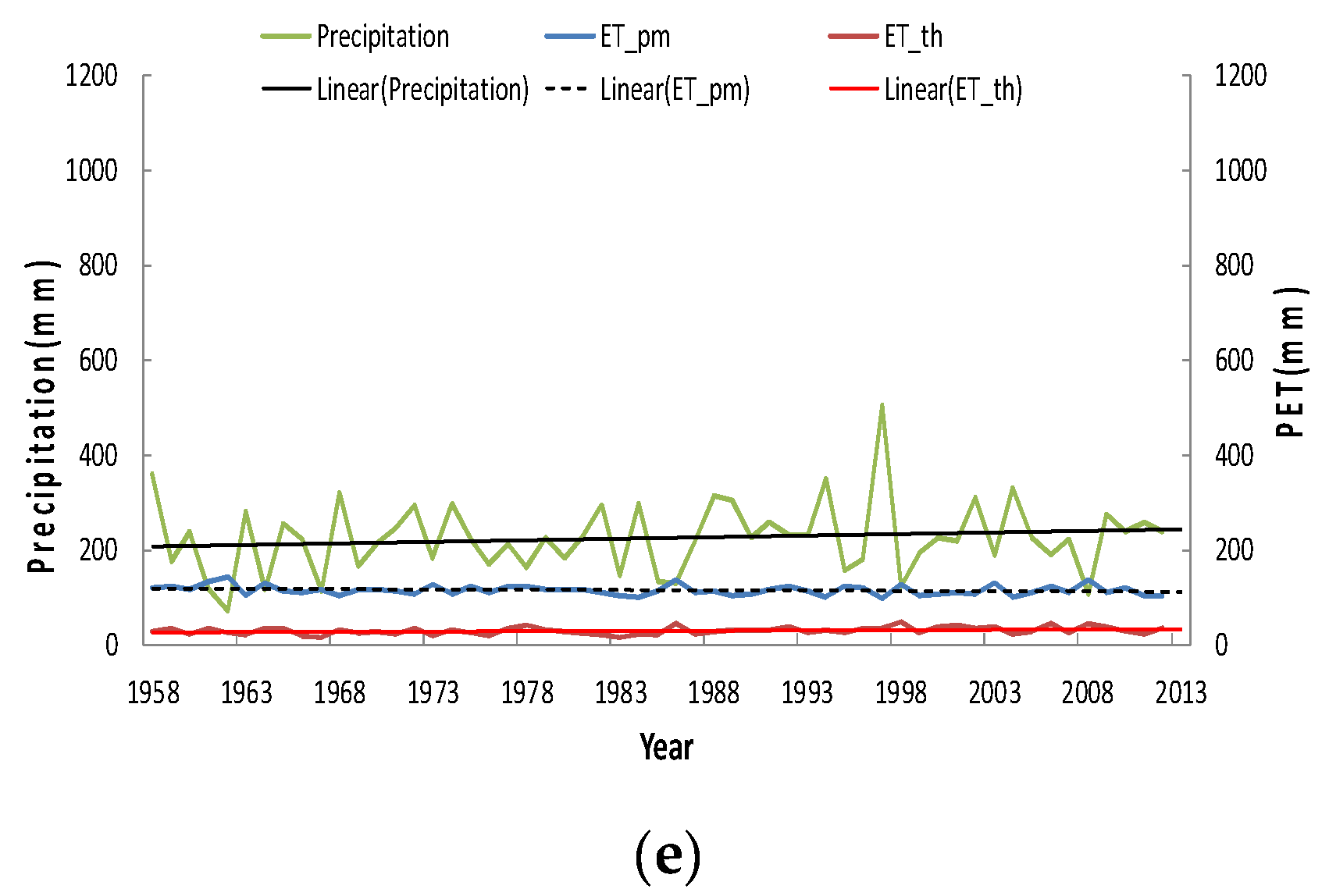
| ID | Station Name | Longitude (°E) | Latitude (°N) | Altitude (m) | Time Period |
|---|---|---|---|---|---|
| 57598 | Xiushui | 114.58 | 29.03 | 146.8 | 1953–2013 |
| 57793 | Yichun | 114.38 | 27.80 | 131.3 | 1953–2013 |
| 57799 | Jian | 114.92 | 27.05 | 71.2 | 1952–2013 |
| 57896 | Shuichuan | 114.50 | 26.33 | 126.1 | 1951–2013 |
| 57993 | Ganxian | 115.00 | 25.87 | 137.5 | 1951–2013 |
| 58519 | Boyang | 116.68 | 29.00 | 40.1 | 1955–2013 |
| 58527 | Jingdezhen | 117.20 | 29.30 | 61.5 | 1953–2013 |
| 58606 | Nanchang | 115.92 | 28.60 | 46.9 | 1951–2013 |
| 58608 | Zhangshu | 115.55 | 28.07 | 30.4 | 1957–2013 |
| 58626 | Guixi | 117.22 | 28.30 | 51.2 | 1953–2013 |
| 58634 | Yushan | 118.25 | 28.68 | 116.3 | 1951–2013 |
| 58715 | Nancheng | 116.65 | 27.58 | 80.8 | 1953–2013 |
| 58813 | Guangchang | 116.33 | 26.85 | 143.8 | 1954–2013 |
| Categories | SPEI/SPI Values |
|---|---|
| Extremely wet | More than 2.00 |
| Severely wet | 1.5 to 1.99 |
| Moderately wet | 1.00 to 1.49 |
| Near normal | −0.99 to 0.99 |
| Moderate drought | −1.49 to −1.00 |
| Severe drought | −1.99 to −1.50 |
| Extreme drought | Less than −2.00 |
| Time | SPEI_pm | SPEI_th | SPI | ||||||
|---|---|---|---|---|---|---|---|---|---|
| Z | Trend | P Value | Z | Trend | P Value | Z | Trend | P Value | |
| Spring | −0.6997 | −0.0067 | 0.4841 | −1.0389 | −0.0101 | 0.2988 | −0.7845 | −0.0054 | 0.4327 |
| Summer | 2.0708* | 0.0160 | 0.0384 | 1.0955 | 0.0094 | 0.2733 | 1.6043 | 0.0124 | 0.1086 |
| Autumn | 0.1343 | 0.0015 | 0.8932 | −0.8552 | −0.0085 | 0.3925 | −0.2474 | −0.0027 | 0.8046 |
| Winter | 1.2196 | 0.0084 | 0.2226 | 0.7985 | 0.0059 | 0.4246 | 1.0744 | 0.0074 | 0.2826 |
| Year | 1.0813 | 0.0112 | 0.2795 | 0.2191 | 0.0024 | 0.8266 | 0.6573 | 0.0066 | 0.5110 |
| Climatic Factor | Spring | Summer | Autumn | Winter | Year | |||||
|---|---|---|---|---|---|---|---|---|---|---|
| SPEI_pm | SPEI_th | SPEI_pm | SPEI_th | SPEI_pm | SPEI_th | SPEI_pm | SPEI_th | SPEI_pm | SPEI_th | |
| Precipitation | 0.9920 | 0.9896 | 0.9839 | 0.9826 | 0.9652 | 0.9637 | 0.9822 | 0.9793 | 0.9903 | 0.9883 |
| ET_pm | −0.7285 | −0.8443 | −0.7484 | −0.7803 | −0.7898 | |||||
| ET_th | −0.4766 | −0.6481 | −0.3522 | −0.1766 | −0.3981 | |||||
| Conditional Probability | P(B|A) | P(A|B) | P(C|A) | P(A|C) | ||||
|---|---|---|---|---|---|---|---|---|
| Wet | Drought | Wet | Drought | Wet | Drought | Wet | Drought | |
| Spring | 0.97 | 0.92 | 0.97 | 0.96 | 0.87 | 0.79 | 1.00 | 0.95 |
| Summer | 0.93 | 0.92 | 0.96 | 0.88 | 0.93 | 0.84 | 1.00 | 0.91 |
| Autumn | 0.97 | 0.87 | 1.00 | 0.87 | 0.97 | 0.84 | 0.93 | 0.96 |
| Winter | 0.91 | 0.96 | 0.97 | 0.88 | 0.82 | 0.96 | 1.00 | 0.96 |
| Year | 0.94 | 0.91 | 0.97 | 0.90 | 0.89 | 0.86 | 0.98 | 0.95 |
© 2019 by the authors. Licensee MDPI, Basel, Switzerland. This article is an open access article distributed under the terms and conditions of the Creative Commons Attribution (CC BY) license (http://creativecommons.org/licenses/by/4.0/).
Share and Cite
Liu, W.; Liu, L. Analysis of Dry/Wet Variations in the Poyang Lake Basin Using Standardized Precipitation Evapotranspiration Index Based on Two Potential Evapotranspiration Algorithms. Water 2019, 11, 1380. https://doi.org/10.3390/w11071380
Liu W, Liu L. Analysis of Dry/Wet Variations in the Poyang Lake Basin Using Standardized Precipitation Evapotranspiration Index Based on Two Potential Evapotranspiration Algorithms. Water. 2019; 11(7):1380. https://doi.org/10.3390/w11071380
Chicago/Turabian StyleLiu, Weilin, and Lina Liu. 2019. "Analysis of Dry/Wet Variations in the Poyang Lake Basin Using Standardized Precipitation Evapotranspiration Index Based on Two Potential Evapotranspiration Algorithms" Water 11, no. 7: 1380. https://doi.org/10.3390/w11071380
APA StyleLiu, W., & Liu, L. (2019). Analysis of Dry/Wet Variations in the Poyang Lake Basin Using Standardized Precipitation Evapotranspiration Index Based on Two Potential Evapotranspiration Algorithms. Water, 11(7), 1380. https://doi.org/10.3390/w11071380





